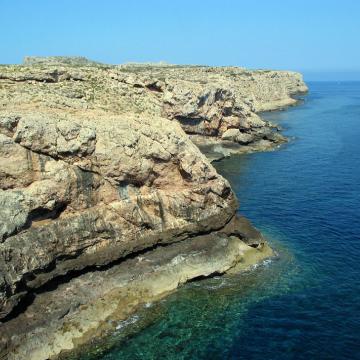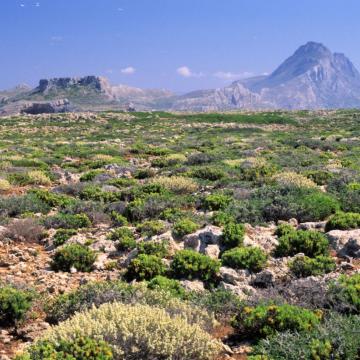GR4340001 - IMERI KAI AGRIA GRAMVOUSSA - TIGANI KAI FALASARNA - PONTIKONISI, ORMOS LIVADI - VIGLIA
Map
Quality
The peninsula and the islands of Gramvousa and Pontikonisi are very important areas for many Greek endemic or stenoendemic plant species as well as for endemic or rare species and subspecies of reptiles and invertebrates (section 3.3). In addition the area is important for migratory birds.It is worth commenting on Anthemis glaberrima, a rare and endangered local endemic plant species of Agria and Imeri Gramvousa, listed on Annex II of the Directive 92/43/EEC. Other interesting species occurring in the site are: Limonium frederici, also an inhabitant of Agria and Imeri Gramvousa, which is endemic to SE Cyclades and Crete and it is a rare species (IUCN, 1993), protected by the Greek Law (Presidential Decree 67/81); Also rare (IUCN 1993) and protected by the Greek Law are the endemic species Trigonella rechingeri (Gramvousa peninsula), Asperula taygetea (Imeri Gramvousa); and Tulipa goulimyi (Falasarna), which is also included in the National Red Data Book (unpublished).Centaurea pumilio is included in the IUCN Red Data List (1993) in the category of threatened plants characterized as rare and protected by the Greek Law (Presidential Decree 67/81).Other non-endemic important species are: Filago aegaea ssp. aristata is a plant with distribution in S & E Aegean, Ionian Islands, Kriti and Cyprus. Cynara cornigera is a species with distribution in S. Greece, the Aegean and Cyprus. Silene fabaria is an Aegean region endemic (occurring only in W Anatolia out of Greece). Malcolmia flexuosa ssp. naxensis is endemic to the Aegean region and Anatolia. Tulipa saxatilis is protected by the Greek Law (Presidential Decree 67/81). Pancratium maritimum used to be a common species of the sandy shores but its populations are gradually decreasing, because of the destruction of its habitat mainly by tourism development (Yannitsaros A. 1979). Ranunculus asiaticus is an East Mediterranean endemic, occurring in Crete and Aegean in Greece, otherwise in Egypt, Libya, Egypt, Sinai, SW Asia. Brassica cretica ssp. cretica is a chasmophyte occurring only in C. and S. Lebanon out of Greece. Scrophularia heterophylla var. heterophylla (= Scrophularia heterophylla ssp. heterophylla) is a balkan endemic. Parietaria cretica is a species with distribution in Sicily, Greece and the Aegean region. Lamyropsis cynaroides is a species (IUCN, 1993). The site is also rich in reptiles, all of them threatened species, legally protected by the Greek Law (Presidential Decree 67/81) and by the Bern Convention (annex II or III). The invertebrate fauna, Mollusca and Orthiptera, is rich in endemic and stenoendemic species, too. Except from Vitrea clessine, which is an Aegean endemic, all the Mollusan species listed on section 3.3. are stenoendemics, exclusively occurring on Gramvousa peninsula or in Western Crete.The grasshopper Poecilimon cretensis is a Cretan endemic. Rare and emdengered rapaces, such as Gyps fulvus and Gypaetus barbatus, live and nest close to or in the site. There is also evidence of the presence of the monk seal, at the northern parts of the peninsula. Tigani lagoon is of major aesthetic importance and it moreover consitutes a shelter and breeding place for many important vertebrate and invertebrate marine species. There is also a considerable population of wild (previously domestic and abandoned) donkeys living throughout the entire peninsula.APPENDIXBecause the site includes plant and invertebrate species which may either be common in more than one parts of the site or occurring in one part only, a list of the species included in 3.3. with their distribution follows (IG=Imeri Gramvousa, AG=Agria Gramvousa, PG=Gramvousa peninsula, T=Tigani, F=Falasarna, P=Pontikonisi)Plants:Allium bourgeaui ssp. creticum FAllium platakisii PAllium rubrovittatum IG, AGAllium tardans AG, IGAnthemis ammanthus AG, IGAsperula rigida PGAsperula taygetea IGBallota pseudodictamnus F, IG, AG, PGCarlina corymbosa ssp. graeca AG, IGCentaurea argentea F, T, PGCentaurea pumilio FCorinilla globosa IGCrepis cretica FCymbalaria microcalyx IGCynara cornigera IGFilago cretensis PGInula candida P, IG, AG, F, TLamyropsis cynaroides F, AG, IGLimonium frederici P, IG, AGMuscari spreitzenhoferi F, AG, IGScrophularia heterophylla IG, AG, PGScutellaria sieberi PGSilene fabaria PStaehelina petiolata F, PGTeucrium microphyllum PGTrigonella graeca FTrigonella rechingeri PGTulipa goulimyi FInvertebrates:Albinaria cretensis PGAlbinaria sp. P (local endemic)Deroceras lasithionensis PGDeroceras rethimnonensis PGHelicopsis bathyptera PGLindbergia orbicullaris PGLindholmiola barbata PGMastus olivaceus PGMetafruticicola lecta P, PG, AGMetafruticicola noversa PGOxychilus spratti PGOxychilus superfluus P, PG, AGPoecilimon cretensis PGTrochoidea mesostena P, PGTrochoidea sp. PGVitrea clessini P, PG, AGReptiles: All the reptiles listed in 3.3. occur in Gramvousa peninsulaOTHER IMPORTANT SPECIES WITH MOTIVATION DThe plant species Lamyropsis cynaroides and Centaurea pumilio are listed in the IUCN Red Data List in the category of threatened species, characterized as rare in Greece (1993) and in Europe (1988), while their World status is unknown. C. pumilio is also protected by protected by the Greek Law (Presidential Decree 67/81). Cynara cornigera is an east-mediterranean species, with interesting distribution in the Aegean area, occurring in Southern Greece, in Crete and in the Aegean and out of Greece only in Cyprus; the site is one of only 100 or less sites this species occurs in the EC. Silene fabaria is an species of Central Greece and of the Aegean, with one report from W. Anatolia, and it is found in 100 or less sites of these species in the ECFor other species listed on section 3.3., explanations are given in the above text.
Other characteristics
The site lays in the western part of Crete, including Granvousa peninsula, the islands Imeri Gramvousa and Agria Gramvousa offshore the northern edge of the peninsula, and the islet Pontikonisi, 10 km west of the centre of the peninsula.Almost all along, the pensinsula consists of rocky calcareous massifs with steep slopes which create rugged coastlines, inaccesible from the sea. Marine caves are a quite common feature of the coastline.The vegetation is mostly phryganic, dominated by the shrubby perennial Sarcopoterium spinosum, Coridothymus capitatus, Callicotome villosa, Cistus creticus and Ballota pseudodictamnus, as well as by dwarf forms (creeping) of Pistacia lentiscus and Ceratonia siliqua.At Balos bay, on the northwest, there are not extended coastal sand dunes with Erica manipuliflora and Pistacia lentiscus, while the area is known for the lagoons that are formed by the mainland and the small Tigani peninsula.The islands Agria and Imeri Gramvousa show almost similar vegetation character, with a greater percentage of rock and sand halophytic species.Falasarna is a coastal belt (5 km in length) in part sandy and in part rocky, with sand-halophytic vegetation, and an inner rocky area covered by phryganic and maquis fromations.
Documentation
1) CORINE Information System. European Environment Agency. CORINE, Biotopes, 1991.
2) Patras University - Ministry of Environment, Physical Planning and Public Works. 1988. (Work Team: Economidou E. et al) Entopismos kai meleti ton ygroviotopon kai allon simantikon gia tin ornithopanida viotopon tis Kritis (Localization and study of wetlands and of other important for the birdfauna biotopes of Crete). Final report, Vol. 1, Patra. p. 384.
3) Ministry of Environment Physical Planning and Public Works. 1990. (Work Team: A. Legakis et al). Erevnitiko programma. Meleti ton akton tis kritis pou parousiazoun oikologikes diatarahes (Research Programme. Study of the coasts of Kriti that present ecological disturbances). Dept. of Biology. University of Crete, p. 228.
4) SIAKAVARA A. Unpuplished data.
5) Kypriotakis, Z. Unpuplished data.
6) Legakis A. (Editor) 1995 . Apeiloumena, Prostateyomena kai Endimika eidi Zoon tis Elladas (Threatened, protected and endemic animal species of Greece). Zoological Museum, University of Athens, p. 35.
7) The red data book of threatened vertebrates of Greece. Hellenic Zoological Society Hellenic Ornithological Society. Athens 1992.
8) Turland N.J., Chilton L. & Press J.R. 1993. Flora of the Cretan area. The Natural History Museum, London : HMSO
9) Valakos, E. Unpuplished data.
10) Vardinoyanni, K. 1994. Biogeografia ton chersaion malakion sto notio nisiotiko aigaiako tokso. Didaktoriki diatrivi. Panepistimio Athinon. (Biogeography of land snails in the south aegean arc. PhD Thesis. University of Athens.
11) Wettstein O. 1953. Herpetologia aegaea. Sber. oest. Akad. Wiss. math.naturw.Kl.Abt.l 162(910): 651833.
12) Helelnic Society for the Study and Protection of the Monk Seal (HSSPMS). 1995. Information and rescue network in Greece. (3.2.c)
13) Helelnic Society for the Study and Protection of the Monk Seal (HSSPMS). 1995. Survey of the centers and of the monk seal population in the Dodekanese region. Final report. EU Contract 4-3040.91.7808. p 19. (3.2.c)
14) Georghiou K. 1995. Checklist of Endemic, Rare and Threatened Plants of Greece. Draft. University of Athens. (3.3, 3.4, 4.2)
15) Morgan V & C. Leon. 1992. Datasheets of Flora species for revision of Appendix I of the Bern Convention. Volume IV. endemic taxa of Cyprus, Greece and Turkey Nature and environment. Nature and Envrionment. No 63 p. 106. Council of Europe, Publishing and Documentaion Service, Strasbourg. (3.2.g.)
16) Yannitsaros A. 1979. Prokatarktiki erevna gia tin prostasia tis chloridas kai tis vlastisis tis Lesvou (Towards the protection of the flora and vegetation of Lesvos: a preliminary study). I Fysis 18:15-25.
17) Tzanoudakis D. & Z. Kypriotakis. 1993. Allium platakisii, a new species of the Greek insular flora. Flora Med. 3:309-314.
Reference: Natura 2000 data form, database release 7 Feb 2014




